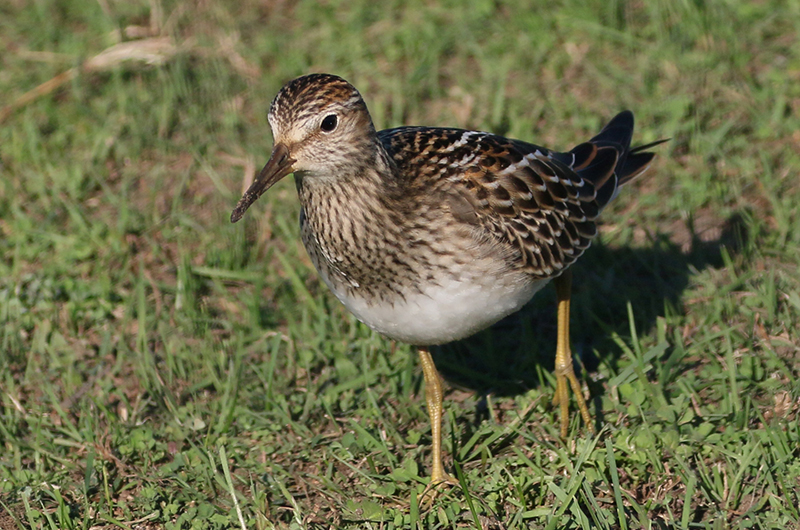So far we have had no luck. The gray heron that was on Tuckernuck and Muskeget last week — the first ever sighting of this species in the continental United States — has not been seen again. Ever the optimists, we were hoping it would continue on to the Vineyard, but if it did we have been unable to find it. Not because have not tried! A number of great blue herons initially looked like the very similar gray heron, but closer looks revealed their true identity. Trying to find this bird has proven more elusive than finding the proverbial needle in a haystack.
Bird Sightings
We have had more luck with the sandhill crane that has been around since April. The sighting on Sept. 10 is fun. Josh reports that while they were walking at Muskoday Farm in Katama, his three year old daughter Eleanor “turned around and shouted to me to look. The crane, which must have been about a foot taller than her, was crossing the wide path behind us. When we told my wife, she said that she had actually seen the same bird when walking the same trail a week or so ago!”
Others have also reported this bird. Rose Leitner saw it Sept. 9, and Stacy O’Donnell saw it on Sept. 11. Stacy Hall saw it on Sept. 13 and has been hearing it for weeks. And I saw it the same day but might have missed it had it not bugled — an unmistakable and wild sound — as it chased two turkeys away.
The pond at the Manuel Correllus State Forest has been productive. Matt Pelikan has been seeing a female northern shoveler at that pond for a month or so. Lanny McDowell spotted the shoveler on Sept. 11, along with two solitary sandpipers squabbling with each other. Those three birds have been there consistently, as Warren Woessner saw them Sept. 12, the same day that Bob Shriber saw them along with fifteen mallard, and two green-winged teal. The two species he added were not there the next day, but I spotted two phoebes, a blue-winged teal, three mallard and the shoveler. For the 15 minutes I was there, the shoveler was busily chowing down on the submergent vegetation in that shallow pond. No wonder it has stayed there.
The yellow-crowned night-heron at Sheriff’s Meadow Sanctuary has been consistently present for about two weeks. Pete Gilmore spotted it and a solitary sandpiper there on both Sept. 6 and 8. On Sept. 9 Stuart Santos saw it and reports finding a brood of four very young bobwhite quail there, and Nick Bonomo also found the heron that day.
Nick Bonomo found the usual common shorebirds on Chilmark Pond on Sept. 11 — black-bellied plover, semipalmated plover, ruddy turnstone, sanderling, least sandpiper, semipalmated sandpiper, greater yellowlegs and lesser yellowlegs. He also spotted pectoral sandpiper, 11 lesser black-backed gulls, merlin, peregrine falcon, northern harrier, Cooper’s hawk, and both a purple finch and bobolinks. He also saw piping plover, killdeer, white-rumped sandpiper, and four pectoral sandpipers on Edgartown Great Pond on Sept. 8.
Hawks are also visible around Katama. Hans Goeckel saw a red-tailed hawk on Sept. 8 and a Cooper’s hawk on Sept. 10. Jeff Bernier spotted a merlin and a northern harrier on Sept. 12. And I spotted northern harrier, turkey vulture and red-tail on Sept. 13.
Eastern screech owls have been more conspicuous recently, their more frequent calling suggesting that this year’s youngsters are becoming independent and starting to establish their own territories. Susan Straight, Will Turner, Nick Bonomo and Allan Keith have all been hearing them.
Some new species are arriving in their southward migration. On Sept 7, Walt Looney spotted the first dunlin of the season at Little Beach and Bob Shriber found a blue-winged warbler in Aquinnah. This past week, Allan Keith spotted both golden-crowned kinglets and a Swainson’s thrush. And Olson Houghton spotted an American wigeon at the Oak Bluffs pumping station on Sept. 14.
Speaking of Little Beach, both Jeff Bernier and Nick Bonomo spotted red knots, ruddy turnstones and American oystercatchers there on Sept. 12. Another species with a large red beak — black skimmers — have abandoned their nesting colony on that beach, but they can regularly be found on Sarson’s Island.
On Sept. 12 Dahlia Rudavsky and Bob Jampol spotted eight great egrets in the marshes at the southern end of Sengekontacket Pond.
Susan Whiting visited the Gay Head cliffs on Sept. 12 and her highlights include 70 tree swallows, 20 cedar waxwings, two dickcissels, a purple finch and a red-breasted nuthatch.
Well south of us over the ocean, LJ Blackwell spotted an American redstart that had landed on his boat and later briefly sang; undoubtedly it was tired after venturing so far offshore and very happy to find some “land” where it could rest.
Finally, ruby-throated hummingbirds are still hanging around. They will soon be departing for southern climes, as Stuart Santos reports their numbers are decreasing. The following observers have reported them this week: Carleton Simonin, Sarah Carr, Kathy Landers, Daisy Kimberly, Hans Goeckel, Pete Gilmore, Jon Parkinson, Susan Whiting, Sea Williams, Bridget Dunnigan, Nick Bonomo, Cynthia Bloomquist and Sandra Talanian.
Please keep your feeders full as we are starting the season when western species of hummingbirds are more likely to show up.
Robert Culbert is an ecological consultant with Nature Watch LLC living in Vineyard Haven.










Comments (1)
Comments
Comment policy »